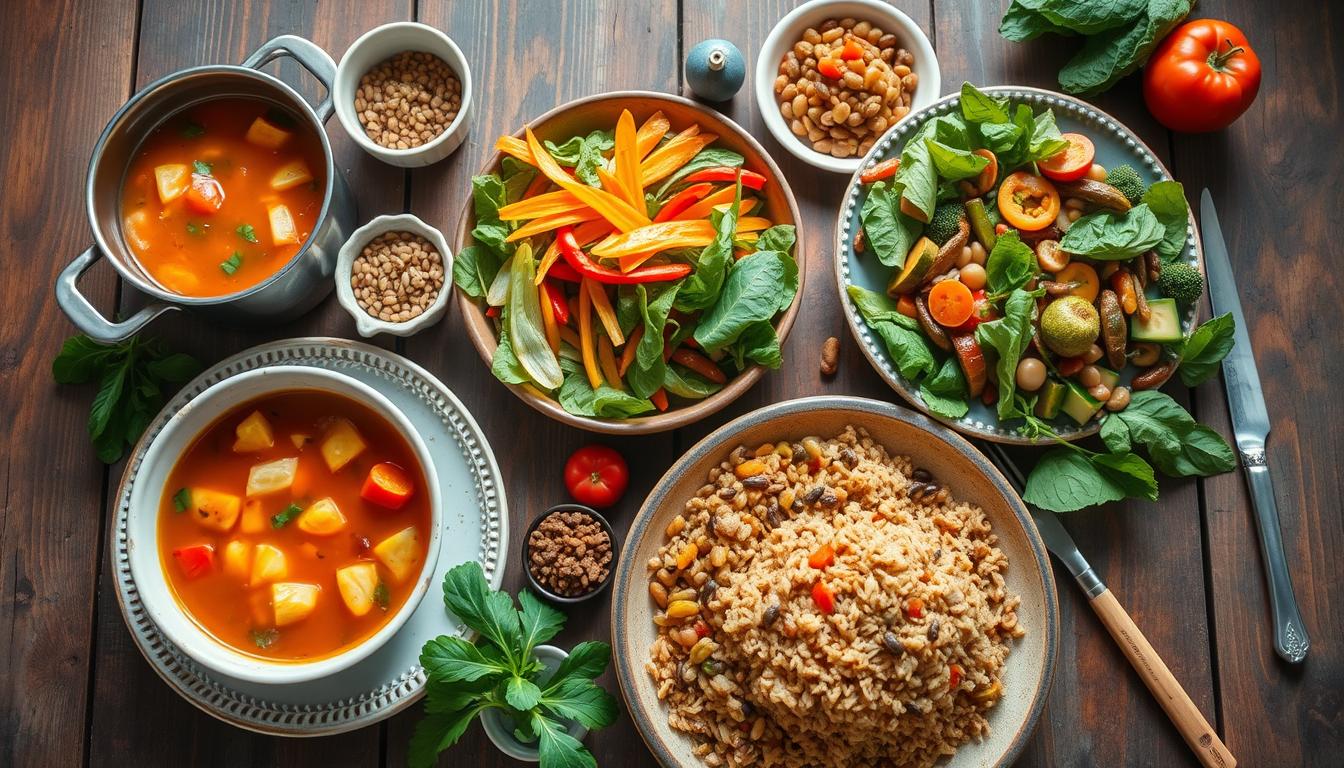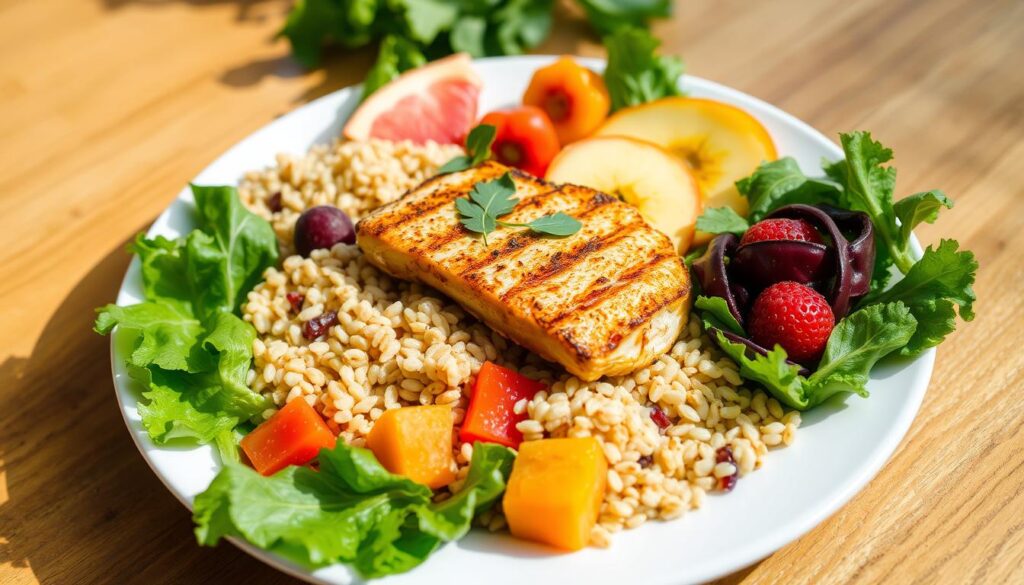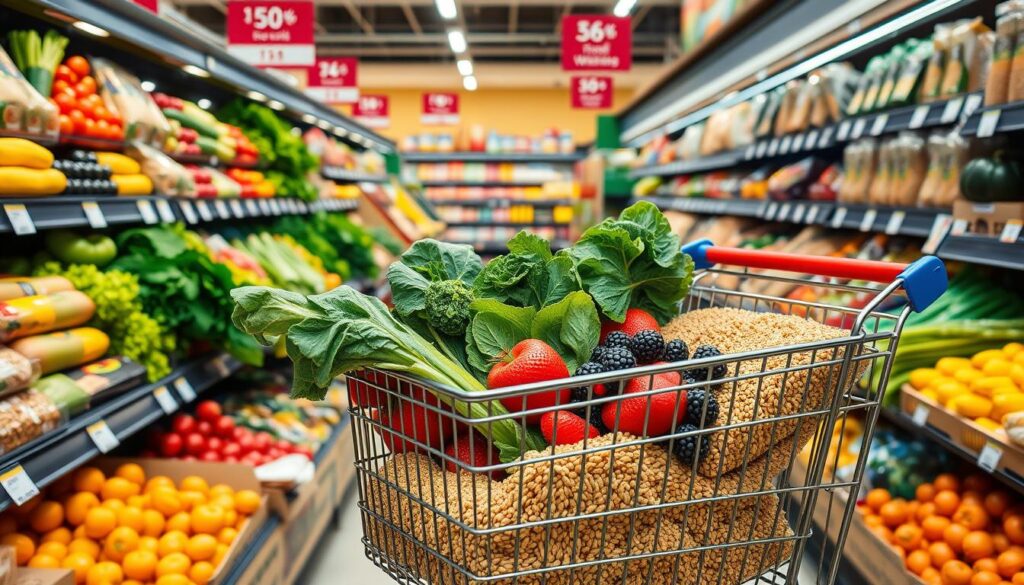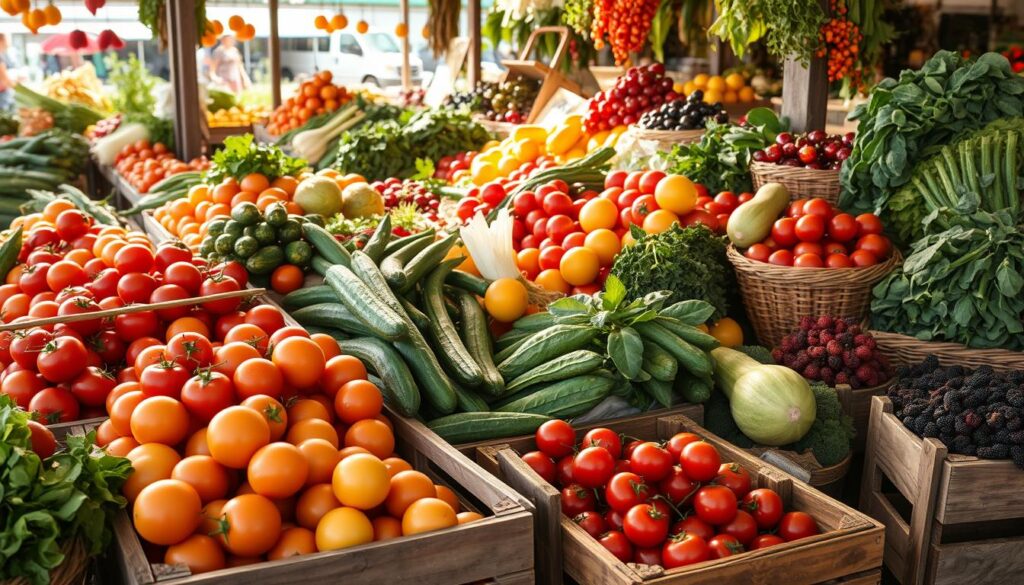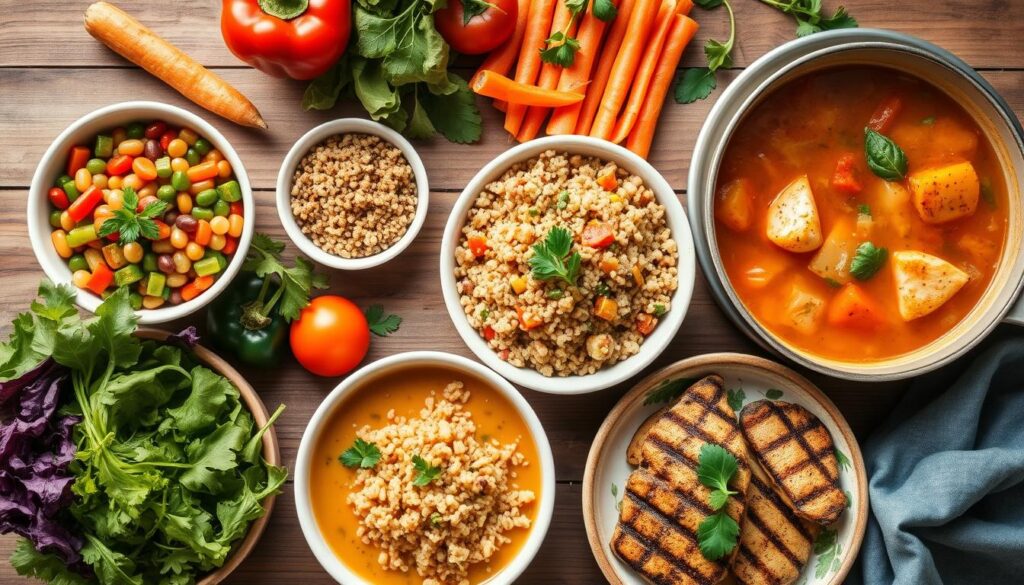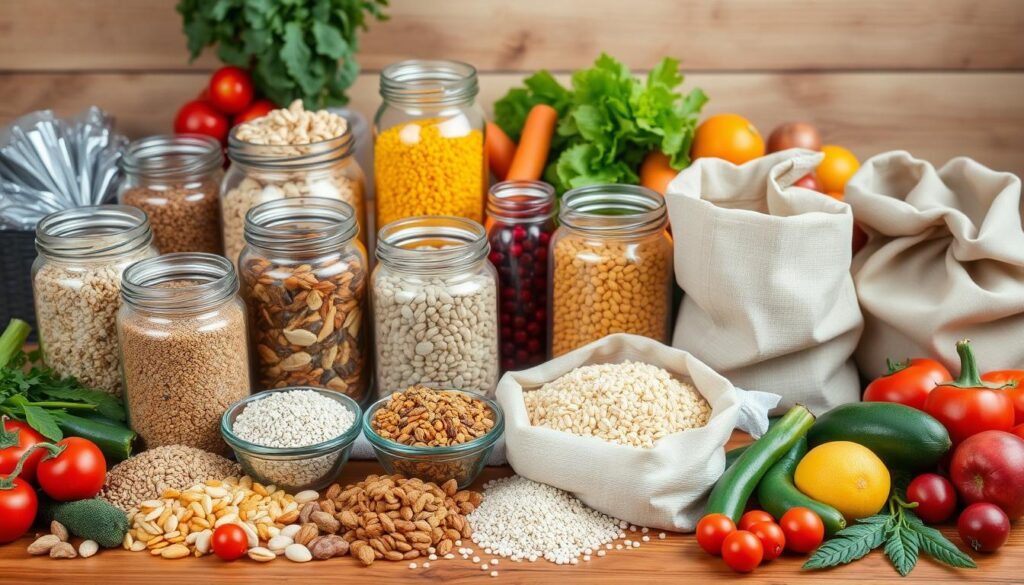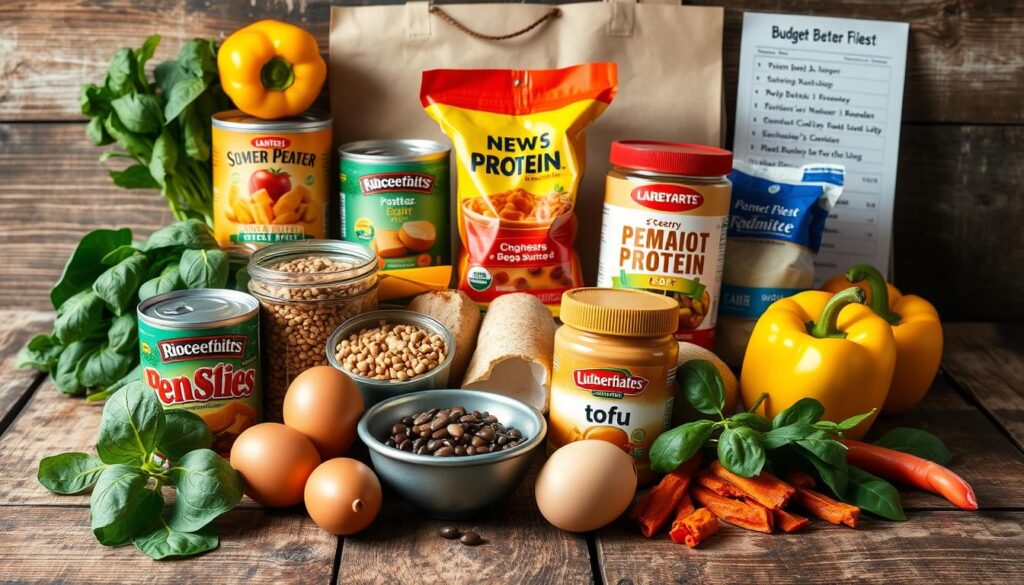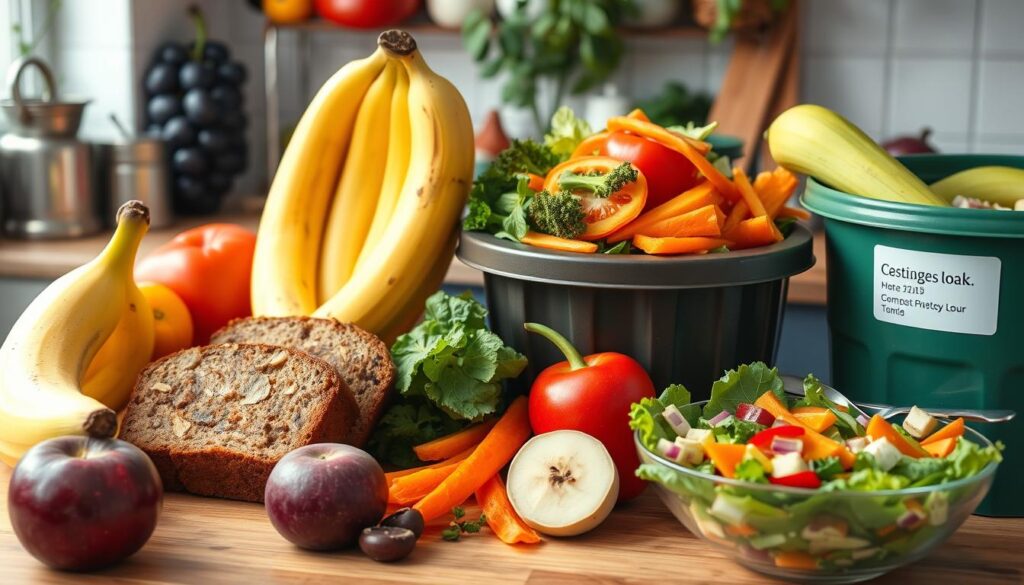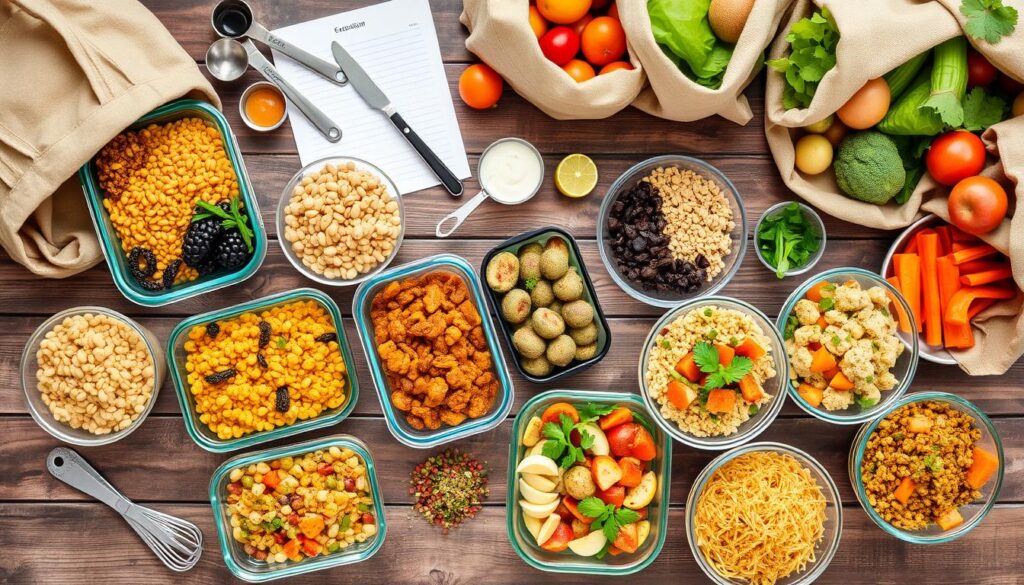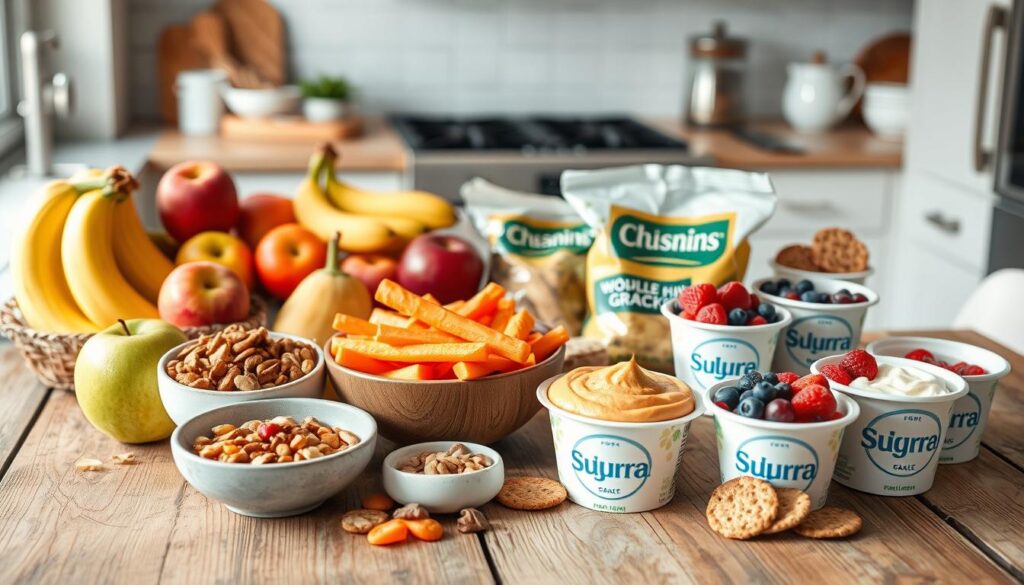In today’s fast world, it’s common to think healthy eating costs a lot. But, with smart strategies, you can eat well without spending a lot. This guide gives you practical tips to eat healthy on a budget.
Whether you’re busy, a student, or a family trying to save, this article helps. It offers tools and knowledge to make smart food choices. You’ll learn how to shop smart, find cheap recipes, and more, all while keeping your wallet happy.
Key Takeaways
- Understand the basics of budget-friendly nutrition and essential nutrients for a balanced diet.
- Discover smart grocery shopping strategies that save you money, including when to buy seasonal produce.
- Learn the fundamentals of meal planning and bulk buying to maximize your food budget.
- Explore affordable protein sources and ways to reduce food waste.
- Uncover budget-friendly snack options and essential kitchen tools worth investing in.
Understanding the Basics of Budget-Friendly Nutrition
Eating healthy doesn’t have to cost a lot. Knowing what your body needs and debunking myths about expensive healthy foods can help. You can eat well without spending too much.
Essential Nutrients for a Balanced Diet
A good diet includes many vitamins, minerals, and macronutrients. Key nutrients to look for are:
- Protein for muscle growth and repair
- Fiber for digestive health and feeling full
- Calcium and vitamin D for strong bones
- Iron for healthy blood and energy
- Antioxidants like vitamins C and E for immune support
You can find these nutrients in foods like beans, eggs, whole grains, leafy greens, and citrus fruits. These are all affordable and packed with nutrients.
Common Misconceptions About Healthy Eating Costs
Many think a dietary guidelines-approved, nutritional value-rich diet is pricey. But, it’s not always true. With smart shopping and knowing affordable options, you can live healthy without spending a lot.
| Misconception | Reality |
|---|---|
| Healthy foods are always more expensive | Many nutritious whole foods, such as beans, lentils, and frozen produce, are actually quite affordable. |
| Organic foods are necessary for a healthy diet | While organic options can be beneficial, conventional produce can also be part of a healthy, budget-friendly diet. |
| Eating out is cheaper than cooking at home | Preparing meals at home, even with fresh ingredients, is often more cost-effective in the long run. |
By understanding these myths and focusing on nutrient-dense, affordable foods, you can enjoy a healthy diet without straining your budget.
Smart Grocery Shopping Strategies That Save Money
Grocery shopping can be tough, especially when you’re on a tight budget. But, there are smart ways to save money without giving up on healthy food.
One key strategy is comparison shopping. Look at flyers and online ads before you go to the store. This way, you can find the best deals and discounts on what you need. It helps you save more money and get the most value for your money.
Another smart move is to join store loyalty programs. Many stores offer rewards, coupons, and other perks for loyal customers. Also, use cash-back apps or browser extensions to find more savings on your shopping.
Being aware of the best times to buy certain food items is also crucial. For example, seasonal produce is cheaper when it’s in season. Non-perishable items might be more affordable when bought in bulk. By planning your shopping trips, you can make your food budget go further.
| Food Item | Best Time to Purchase |
|---|---|
| Apples | September to November |
| Broccoli | October to April |
| Ground Beef | September to November |
| Canned Goods | Year-round, especially when on sale |
By using these grocery shopping tips and food budgeting strategies, you can save a lot of money. And you can still enjoy a healthy, balanced diet. Remember, every little bit of savings helps when you’re grocery shopping on a budget.
Seasonal Produce Shopping Guide for Maximum Savings
Savvy shoppers know that eating healthy on a budget starts with seasonal produce. By matching your grocery list with nature’s cycles, you can find cheap nutritious foods and save money.
Best Times to Buy Different Fruits and Vegetables
Each crop has its peak season. Here’s a guide to help you shop smart:
- Spring: Asparagus, rhubarb, peas, and leafy greens
- Summer: Tomatoes, zucchini, corn, berries, and stone fruits
- Fall: Apples, pears, pumpkins, brussels sprouts, and root vegetables
- Winter: Citrus fruits, broccoli, cauliflower, and hearty greens
Local Farmers Markets vs. Supermarkets
For grocery shopping tips, local farmers markets are a treasure trove. They offer fresh, affordable produce and support your community.
| Farmers Markets | Supermarkets |
|---|---|
| Directly support local farmers | Centralized distribution chains |
| Produce is ultra-fresh and in-season | Offer year-round availability, but quality may vary |
| Prices are often lower than supermarkets | Prices are typically higher for the same seasonal items |
| Limited selection, but highly diverse | Wider selection, but less variety in seasonal produce |
By knowing when to shop and where, you can find cheap nutritious foods. This will make your grocery shopping tips even more effective for saving money.
How to Eat Healthy on a Budget
Eating well doesn’t have to cost a lot. With smart planning and creativity, you can make healthy meals that are easy on your wallet. Here are some tips to help you eat healthy on a budget and enjoy budget-friendly meals.
Start with whole, unprocessed foods. Fruits, veggies, whole grains, lean proteins, and healthy fats are cheaper than processed foods. Buying in-season produce, choosing frozen options, and shopping at local farmers markets can save you money.
Meal planning is another great strategy. Spend some time each week planning your meals and making a grocery list. This helps you avoid buying things you don’t need and reduces waste. Cooking in bulk and freezing leftovers can also help stretch your budget.
| Budget-Friendly Protein Sources | Affordable Meat Choices |
|---|---|
| Beans, lentils, and legumes | Ground turkey or chicken |
| Tofu and tempeh | Chicken thighs and drumsticks |
| Eggs | Pork shoulder or ground pork |
Remember to always have affordable pantry staples on hand. Things like whole grains, canned goods, and spices are cheap but versatile. They can help you make many budget-friendly meals. With a bit of creativity and planning, you can eat well without spending a lot.
“Eating healthy on a budget is all about making smart choices and being resourceful in the kitchen. It’s a rewarding challenge that pays off in the long run.”
Meal Planning Fundamentals for Cost-Effective Eating
Effective meal planning is key to eating healthy without spending a lot. By planning your meals and making shopping lists, you can save money and eat well. This way, you’ll have nutritious meals all week long.
Weekly Menu Creation Tips
Begin by planning your meals for the week. Think about your schedule and pick recipes that are quick and easy. Make sure to include a variety of foods like proteins, veggies, and whole grains. Also, check what you already have before you finalize your menu.
Shopping List Organization Methods
After planning your meals, make a detailed shopping list. Organize it by category, like produce, dairy, grains, and proteins. This makes your grocery trip faster and helps you avoid buying things you don’t need. By sticking to your list, you can buy only what you need and reduce waste.
| Meal Planning Tips | Shopping List Organization |
|---|---|
|
|
By using these tips for meal planning and shopping list organization, you can manage your food budget better. You’ll enjoy healthy, affordable meals all week.
Bulk Buying Benefits and Storage Solutions
Buying in bulk can save you a lot of money. It also helps reduce food waste by letting you buy more staple items. But, it’s important to store these items properly to keep them fresh and good quality.
One big plus of buying in bulk is the cost savings. You can get items at a lower price per unit, which stretches your budget. This is especially true for non-perishable items like grains, legumes, and spices, which last longer.
- Bulk buying can save you up to 25% on the cost of certain items compared to buying smaller individual packages.
- Purchasing in bulk reduces packaging waste, making it a more environmentally-friendly option.
- Bulk items often have a longer shelf life, allowing you to stock up and avoid frequent trips to the grocery store.
To get the most out of bulk buying, you need to store things right. Using airtight containers, resealable bags, and good storage systems helps keep your food fresh and quality high. Knowing the best storage for different foods can also help them last longer and prevent them from going bad.
| Bulk Item | Optimal Storage |
|---|---|
| Grains (rice, oats, quinoa) | Airtight containers in a cool, dark place |
| Nuts and seeds | Airtight containers in the refrigerator or freezer |
| Dried beans and legumes | Airtight containers in a cool, dry place |
| Spices and herbs | Airtight containers in a cool, dark place |
By using smart bulk buying and storage, you can save money and eat well. This can really change how you manage your grocery budget.
Budget-Friendly Protein Sources and Alternatives
It’s possible to eat well without spending a lot. There are many affordable protein sources that fit your dietary needs. Discover how to add these to your meals.
Plant-Based Protein Options
Legumes like beans, lentils, and chickpeas are cheap and full of protein. They can be used in many dishes, from soups to salads. Tofu and tempeh are also affordable and versatile.
Affordable Meat Choices
Not all meat is expensive. Look for whole chickens or chicken thighs for less money than breasts. Ground turkey or beef are also good and affordable.
| Protein Source | Cost per Serving | Protein Content |
|---|---|---|
| Lentils | $0.25 | 9g per 1/2 cup |
| Chicken Thighs | $1.50 | 28g per 4oz serving |
| Tofu | $0.75 | 10g per 1/2 cup |
| Ground Turkey | $2.00 | 20g per 4oz serving |
Adding these affordable proteins to your meals can make your diet balanced and affordable. Find creative ways to include them in your meals.
Smart Ways to Reduce Food Waste
When trying to eat healthy on a budget, cutting down on food waste is key. By using smart strategies, you can make your food budget go further. This includes storing food right and finding new uses for leftovers. These tips help you waste less and get more value from your food budget.
Mastering Food Storage Techniques
Storing food properly is the first step to reducing waste. Learn how to keep food fresh longer by knowing the best storage conditions. Using airtight containers and freezer bags, and following the right storage methods, can really help prevent food from spoiling too soon.
Transforming Leftovers with Culinary Creativity
Don’t let leftovers go to waste. Get creative and turn them into new, tasty meals. You can make everything from stir-fries and casseroles to soups and sandwiches. With a bit of creativity, you can make leftovers into delicious, budget-friendly dishes.
Meal Planning for Waste Reduction
Good meal planning can greatly reduce food waste. Plan your meals and shopping list carefully to use up all ingredients before they expire. Choose recipes that use up items close to their expiration date, and find ways to reuse versatile ingredients in different dishes.
| Food Item | Average Shelf Life | Storage Tips |
|---|---|---|
| Fresh Produce | 3-7 days | Store in the fridge, use airtight containers or bags |
| Dairy Products | 5-7 days | Keep in the refrigerator, check expiration dates |
| Meat and Poultry | 1-3 days (fresh), 3-4 months (frozen) | Freeze for longer storage, thaw properly before use |
| Grains and Pasta | 6-12 months (dry) | Store in airtight containers in a cool, dry place |
By using these smart strategies, you can cut down on food waste and stretch your budget. These tips help you make the most of every ingredient. This way, your healthy eating journey will be both nourishing and affordable.
Freezer-Friendly Meals and Money-Saving Tips
Preparing budget-friendly meals doesn’t mean you have to give up taste or nutrition. Freezer-friendly meals are a great way to save time and money. By cooking in batches and using the right storage, you can enjoy tasty, healthy meals without breaking the bank.
Proper Food Storage Techniques
For freezer-friendly meals, knowing how to store food is key. Invest in high-quality airtight containers or freezer-safe bags to keep food fresh. Make sure to label each container with what’s inside and when you stored it. Always follow the storage times for different foods.
Batch Cooking Guidelines
- Plan your meals ahead and pick recipes that freeze well, like soups, stews, casseroles, and pasta dishes.
- Set aside time on the weekend or a day when you’re free to cook in bulk.
- Use bigger pots, pans, and baking dishes for batch cooking. This helps you use your oven space wisely.
- Divide meals into individual portions and freeze them for quick meals all week.
Mastering freezer-friendly meals and batch cooking saves you time and money. With some planning and prep, your freezer can be filled with affordable, nutritious meals. This makes meal planning easy and stress-free.
Affordable Healthy Snacks and Alternatives
Eating healthy doesn’t have to cost a lot. There are many affordable, nutritious snacks that taste great and won’t empty your wallet.
Try making your own trail mix. Mix nuts, seeds, dried fruit, and dark chocolate for a snack full of protein and fiber. Another easy option is to slice fresh fruits like apples, bananas, or oranges. Add a bit of natural peanut butter for extra flavor.
- Cottage cheese with fresh berries
- Air-popped popcorn with a sprinkle of parmesan cheese
- Hummus with carrot or cucumber sticks
- Hard-boiled eggs with a sprinkle of salt and pepper
Don’t forget about cheap nutritious foods like canned and frozen items. Canned tuna, salmon, or chickpeas are great in salads or sandwiches. Frozen fruits and veggies are just as good as fresh ones.
| Snack | Cost Per Serving | Nutritional Benefits |
|---|---|---|
| Homemade Trail Mix | $0.50 – $1.00 | High in protein, fiber, and healthy fats |
| Apple Slices with Peanut Butter | $0.75 – $1.25 | Good source of fiber, vitamins, and plant-based protein |
| Cottage Cheese with Berries | $1.00 – $1.50 | High in protein, calcium, and antioxidants |
Adding these affordable, nutritious snacks to your dietary guidelines lets you enjoy tasty treats. You can stay on track with your health and budget goals.
Kitchen Tools Worth Investing In
When it comes to food budgeting and eating healthy on a budget, the right kitchen tools are key. Essential equipment and gadgets can make cooking easier, save time, and help you eat well without spending a lot.
Essential Equipment for Budget Cooking
For budget-friendly cooking, you need a sharp chef’s knife, a sturdy cutting board, and reliable pots and pans. These tools make chopping veggies and cooking meals like soups and stews a breeze.
- A high-quality chef’s knife, which can make quick work of cutting and dicing ingredients
- A large cutting board to provide ample workspace for food prep
- A set of durable, non-stick pots and pans to cook meals efficiently
Money-Saving Kitchen Gadgets
There are also kitchen gadgets that save money over time. From tools for meal prep to storage solutions, these gadgets help you cook better and waste less food.
- A slow cooker or Instant Pot, which can transform inexpensive cuts of meat into tender, flavorful dishes
- A reusable silicone bag or container set for storing leftover food and reducing plastic waste
- A high-quality blender or food processor, which can help you create homemade sauces, dips, and smoothies
Investing in the right kitchen tools makes food budgeting and healthy eating easier. It saves time and money, letting you focus on making tasty, healthy meals without breaking the bank.
Quick and Nutritious Budget-Friendly Recipes
Eating healthy doesn’t have to cost a lot. With a bit of creativity and planning, you can make tasty, nutritious meals without spending much. Check out these easy, affordable recipes that are full of flavor and good for you.
Hearty Lentil Stew
Lentils are a cheap but super nutritious food. They’re full of fiber, protein, and vitamins. This stew mixes lentils with veggies, herbs, and tomato for a warm, filling meal.
- In a big pot, cook onions, carrots, and celery in olive oil until they’re soft.
- Add lentils, diced tomatoes, vegetable broth, and your favorite herbs and spices.
- Let it simmer for 20-25 minutes, until the lentils are soft.
- Top with fresh parsley or cilantro and serve hot.
Baked Sweet Potato Fries
Sweet potatoes are cheap and very nutritious. These baked fries are a tasty side dish that goes well with many meals.
- Heat your oven to 400°F (200°C).
- Peel and cut sweet potatoes into thin fry shapes.
- Drizzle with olive oil, salt, and any seasonings you like.
- Put the fries on a baking sheet in one layer. Bake for 20-25 minutes, flipping halfway, until crispy and golden.
These are just a few ideas for delicious, affordable meals you can make at home. By using cheap, nutritious ingredients and simple cooking, you can enjoy healthy meals without spending a lot.
Making the Most of Leftovers
Reducing food waste is good for the planet and can save you money. Turning leftovers into new meals is a smart way to stretch your food budget. With a bit of creativity and smart storage, you can make the most of your leftovers.
Creative Leftover Transformations
Don’t let leftovers go to waste! Get creative and turn them into new dishes. Here are some ideas to get you started:
- Turn extra grilled chicken into a flavorful stir-fry or chicken salad.
- Repurpose roasted vegetables into a hearty soup or frittata.
- Combine leftover rice, beans, and salsa for a quick and easy burrito bowl.
- Transform extra pasta into a baked casserole or frittata.
- Reinvent meatloaf or meatballs by using them in sandwiches, tacos, or pasta dishes.
Safe Food Storage Timeline
Proper food storage keeps leftovers fresh and safe. Here’s a quick guide to help you store leftovers properly:
| Food Item | Refrigerator (40°F or below) | Freezer (0°F or below) |
|---|---|---|
| Cooked Meat or Poultry | 3-4 days | 2-6 months |
| Cooked Vegetables | 3-4 days | 8-12 months |
| Cooked Pasta or Rice | 3-4 days | 6-8 months |
| Cooked Soups or Stews | 3-4 days | 2-3 months |
By following these storage tips and getting creative with leftovers, you can save money and reduce waste. This makes meal planning and budgeting easier.
Understanding Food Labels and Price Comparison
Shopping for groceries can feel like a big challenge. It’s hard to pick healthy and affordable options. But, by learning about food labels and comparing prices, you can shop smarter. This way, you get more nutrition for your money.
Reading food labels is key to making good choices. Ignore the flashy ads and look at the nutrition facts. Check the serving size, calories, and nutrients like protein and vitamins. Then, compare different products to find the best value.
When comparing prices, don’t just look at the tag. Calculate the unit price, which shows cost per ounce or pound. This helps you see which brands and sizes offer the best deal.
- Understand the information on food labels, including serving size, calorie content, and nutrient values.
- Compare unit prices to find the best value, rather than just the sticker price.
- Seek out discounted or sale items, but don’t sacrifice nutritional quality.
- Consider the long-term savings of buying in bulk for non-perishable items.
Learning to read labels and compare prices makes you a better grocery shopper. You’ll make choices that are good for your health and your wallet. This skill helps you eat well without breaking the bank.
“Knowledge is power, and understanding food labels and prices is the key to unlocking the secrets of cost-effective, healthy eating.”
Building a Healthy Pantry on a Budget
Having a well-stocked pantry is key to making healthy, affordable meals. By choosing affordable, versatile items, you can make many healthy dishes without spending a lot. Let’s look at some essential items for your budget-friendly pantry.
Whole Grains
Choose whole grains like brown rice, whole wheat pasta, and oats. These foods are full of nutrients and give you energy and fiber. They’re a great choice for cheap nutritious foods.
Legumes
- Canned or dried beans, lentils, and chickpeas are packed with protein, fiber, and carbs. They’re cheap nutritious foods.
- These ingredients are great for many dishes, from soups to veggie burgers and dips.
Canned and Frozen Produce
Fresh fruits and veggies can be expensive. But canned and frozen options are cheaper and just as good for you. Keep canned tomatoes, frozen broccoli, and berries on hand for cheap nutritious foods.
Healthy Fats and Oils
Use heart-healthy fats like olive oil, avocado oil, and nut butters. They add flavor and are good for you. These pantry items help with food budgeting.
Spices and Herbs
A good spice cabinet can make simple ingredients taste great. Get affordable spices like garlic powder, onion powder, and dried herbs. They add flavor to your cheap nutritious foods.
| Pantry Item | Nutritional Benefits | Average Cost per Serving |
|---|---|---|
| Brown Rice (1 cup, dry) | Whole grains, fiber, complex carbs | $0.20 |
| Canned Chickpeas (15 oz can) | Protein, fiber, complex carbs | $0.50 |
| Frozen Broccoli (1 cup) | Vitamins, minerals, antioxidants | $0.30 |
| Peanut Butter (2 tbsp) | Healthy fats, protein | $0.25 |
Stock your pantry with these affordable, nutritious items. This way, you can make delicious, budget-friendly meals. With some planning and creativity, you can enjoy cheap nutritious foods that are good for you and your wallet.
Conclusion
In this guide, we’ve covered how to eat healthy without spending a lot. You now know how to make nutritious meals that fit your budget and lifestyle. This includes understanding budget-friendly nutrition and smart shopping.
Using seasonal produce, buying in bulk, and finding affordable proteins can make meals affordable. Meal planning, storing food well, and reducing waste also help save money. These tips can make your food budget go further.
Eating healthy on a budget is not only possible but also rewarding. With the right tips and a bit of creativity, you can enjoy tasty budget-friendly meals. Start using these strategies to improve your health and finances.


